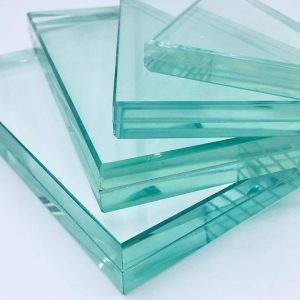Advantages & Disadvantages of Laminated Glass
When you look at laminated glass on its edge, you can determine if it’s been laminated. A visible interlayer is present in laminated glass. When knocked on, it also makes a different sound than annealed or tempered glass.
Table of Contents

Uses for Laminated Glass
Laminated is considered a type of safety glass, when broken, the the interlayer holds the glass together and keeps it from falling out of the frame and causing injury.
It can be utilised in any environment where security is a top priority. This includes storefront windows and doors or areas.
How is laminated glass made?
The process includes steps such as cutting, hot pressing and lamination between two sheets of glass and a plastic interlayer (PVB). The glass edges are sealed and heated under pressure at temperatures ranging from 100-200 degrees Celsius; this fuses the layers together permanently Some types of laminated glass have a thin film on the inside for additional protection
Is laminated glass expensive?
Laminated glass is typically around 3x more expensive than regular float glass. For example, 6.38mm laminated glass would cost you approximately $75 per sqm compared with float glass which is approximately $25 per sqm for the same thickness.
Benefits of Laminated Glass
- Increased security: Laminated glass is extremely difficult to break, any unauthorised person would have a difficult time gaining access. Even if a crack occurs, the interlayers maintain the structure’s strength, making enlarging the opening extremely difficult.
- Reduced emissions: Low-emissivity glass can help to reduce heat input from the sun, allowing for less frequent usage of air conditioning and lower emissions.
- Reduced noise pollution: When a thick piece of laminated glass is installed, noise waves are interrupted as they travel through the material, reducing noise pollution.
- Increased safety: Since the glass does not shatter when broken, the chance of being cut or hurt by shards of glass is decreased.
- Natural disaster protection: When natural catastrophes or unpredictable weather strike, laminated glass will remain in its frame, lowering the danger of accidents and making a potentially life-threatening scenario slightly safer.
- More options for design: Laminated glazing comes in a variety of colours, tints, and tones, and can be either straight or curved for a more versatile look.
Disadvantage of Laminated Glass
- Laminated glass is more expensive than both float glass and tempered glass
- When the edge of the laminated glass is exposed to water over an extended period of time, such as condensation, it might deteriorate and cause “clouding” of the glass
ABOUT THE AUTHOR

Ramy Jbeili
Ramy is the head glazier and owner of Quik Window Glass Replacement with many years experience as a window glass replacement specialists
